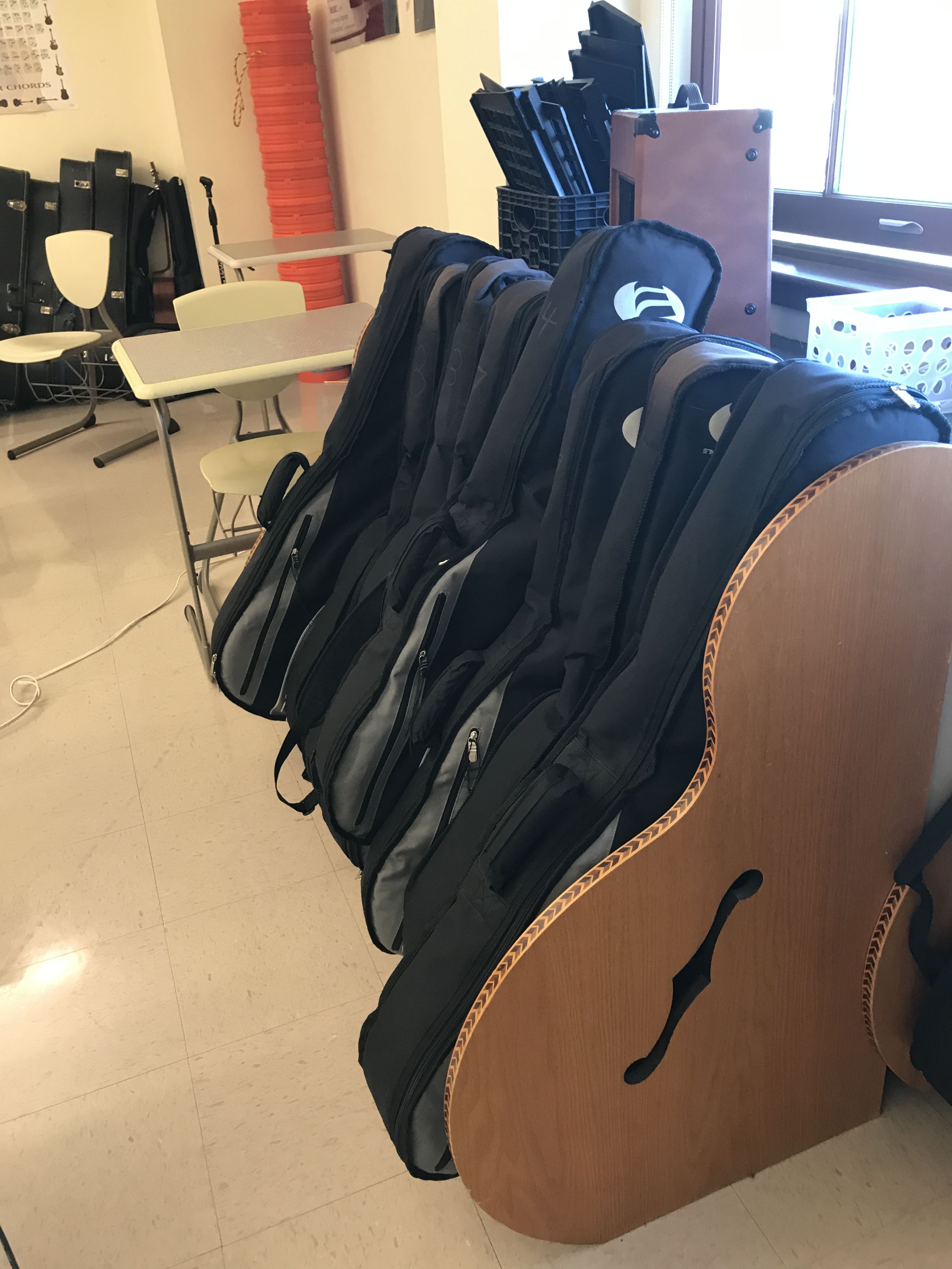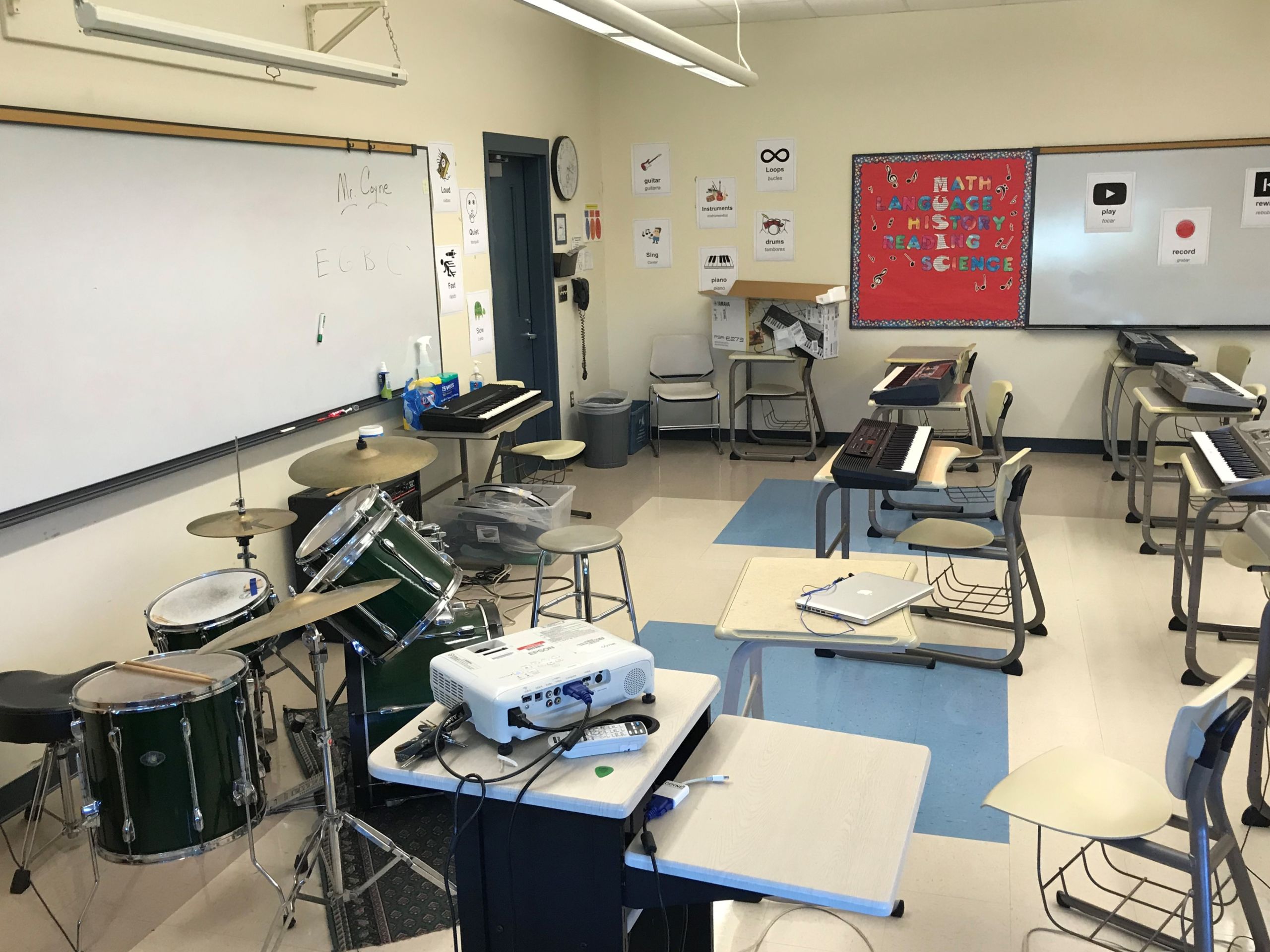Kevin Coyne
Music Teacher at McDevitt Middle School

Kevin Coyne, a general music teacher at McDevitt Middle School in Waltham, was used to hearing the banging of bucket drums and the strumming of guitars in his classroom. However, all of that was silenced when schools across the state shut down during the pandemic. In Coyne’s classroom, homework assignments using online computer programs like BandLab and GarageBand replaced the instruments students used in class, and the eight-piece drum set that Coyne said could always manage to catch students’ interest in class was left unused.
Coyne said that one of the biggest challenges of teaching during the pandemic is ensuring that students are feeling supported. In order to ensure that students are getting what they need from class, Coyne said he’s been cutting back on music instruction in favor of making connections with students by starting class with a silly question and talking with students about their lives in breakout rooms.
“I don't really feel like i'm giving them the true musical experience that I want them to have,” Coyne said. “I got rid of part of my curriculum just so we can spend time making sure that we're connecting and engaging so I can be that mentor.”
Coyne typically starts class with a silly question, something that the teacher said is one of his students’ favorite activities that he added this school year. The educator also said he likes to check in on how students are doing while they’re working in breakout rooms. Creating these connections have been crucial to keeping students engaged in what’s going on in class, and it helps Coyne be more accessible to students if they need help.
“I spend a few minutes just talking to kids individually,” Coyne said. “It makes a huge difference, and a lot of my talking to them isn’t about the project, it’s ‘hey how’s it going.’”
However, the transition to remote learning has not been perfect. McDevitt Middle School adopted a hybrid model for the 2020-21 school year. With two thirds of students at McDevitt not speaking English as their first language, the model was crucial in providing students with specific needs like language support. Other students, like the ones in Coyne’s music class for students with autism, also need the in-person support the hybrid model provides. Though these have been important measures to ensure learning, Coyne said the hybrid model posed the challenge of how to divide attention between students in class and those online.
“You either spend all your time focusing on the kids in class and ignoring the kids online, or focusing on the kids online and ignoring the kids in class — so somebody always suffers in that situation,” Coyne said. “Students are not getting the personal attention that they would get from me, and so they just come in and they just think about getting the absolute minimum done.”
The extra strain that the pandemic has put on students has also reflected in their performance, despite Coyne’s best efforts to support students. Online classes have made attendance spotty for some, and Coyne said that he’s had to give out more failing grades this year than ever before.
“They're just struggling at home and that's across the board, I think you'll find that in any school district,” Coyne said, “And a lot of times you find out that the families are struggling as well. I know if they're not connecting right now into class when I know that they can and they've connected in the past, there's something else going on.”
Adjusting to hybrid teaching has taken a toll on Coyne as well. Alongside the enormous task of coming up with a new curriculum, the projects students are creating demand far more time for grading than Coyne is used to.
“If i'm giving them this assignment in class to go and make this piece of music, well then, it's kind of silly if I don't go and listen to every kid’s song,” Coyne said.
However, Coyne teaches over 220 students, meaning that giving feedback on each assignment that may last anywhere from 30 seconds to a few minutes takes hours.
With McDevitt Middle School returning to full in-person schooling on April 28 alongside other middle schools across the state, Coyne hopes to engage more with students and drastically decrease screen time during his lessons. The in-person return means that students will be able to take the kinds of lessons Coyne taught before the pandemic, albeit with small tweaks to allow for distancing. However, Coyne said he is still planning on integrating lessons he created during the pandemic in the future.
“No matter what we're doing, any lesson is going to be better when I can see the kids in person,” Coyne said.
This added flexibility is something Coyne thinks will continue to grow in popularity even after the pandemic ends.
“Online learning has been very prolific in colleges and universities, but not so much in public schooling,” Coyne said. “The pandemic has forced us to really embrace online learning and I think there will be more options now for students who can't be in school or do not feel safe being in school.”
Photos courtesy of Kevin Coyne

Though Coyne usually groups students in pairs and groups of four, the need to distance in classrooms has made a new seating arrangement necessary.
Though Coyne usually groups students in pairs and groups of four, the need to distance in classrooms has made a new seating arrangement necessary.

Coyne's drum set, a fixture in his classroom for getting students interested in music making, sits at the front of the classroom.
Coyne's drum set, a fixture in his classroom for getting students interested in music making, sits at the front of the classroom.

Classroom guitars await the return of students.
Classroom guitars await the return of students.

Students are now required to sit three feet apart while at school.
Students are now required to sit three feet apart while at school.
